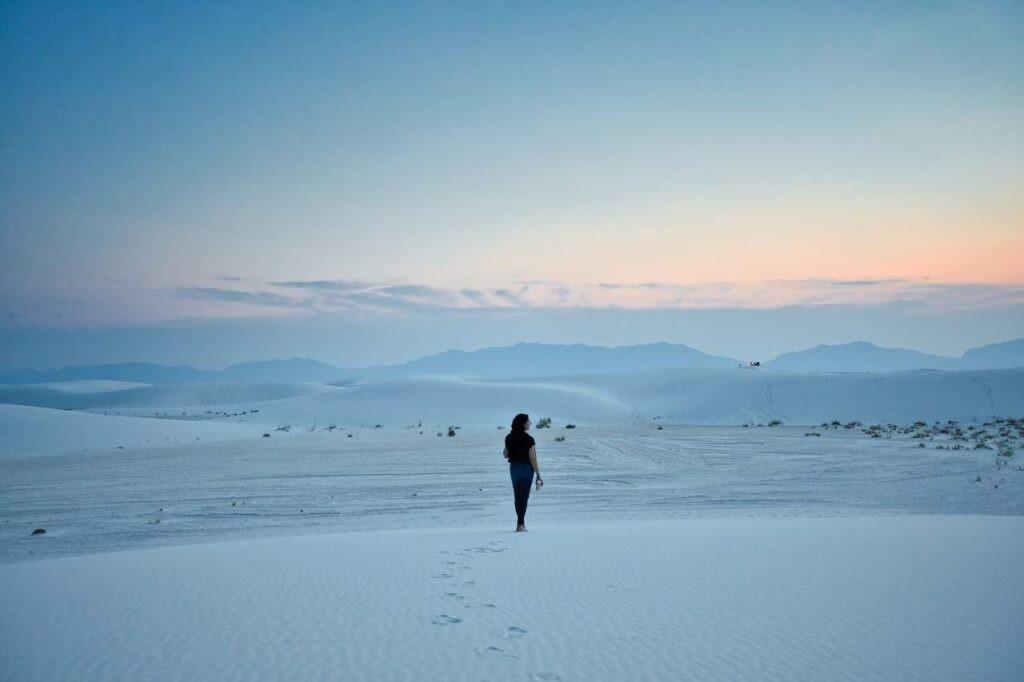Discover the Prehistoric Magic in the Tularosa Basin
You’ve likely visited or are planning to visit White Sands for its breathtaking dunes, but have you ever wondered how the largest gypsum dune field in the world was formed? These dunes are so vast that they can even be seen from outer space! During winter, White Sands National Park offers ranger-led tours of Lake Lucero, formerly known as Lake Otero—a body of water once as large as Rhode Island!
Lake Lucero Now
Lake Lucero is no longer the giant lake it once was. It is now a smaller “playa” or lakebed, located southwest of White Sands National Park and east of the San Andres Mountains. Once a lush, thriving environment, it is now home to many Selenite crystals that continue creating the gypsum dunes in southern New Mexico. What naturally occurs at Lake Lucero is the very origin of these magnificent White Sand dunes.
Tours of Lake Lucero
The Lake Lucero 3-hour tours, held once monthly, reveal the history and magic behind the creation of the stunning dunes, which are still actively forming today. This area, now White Sands National Park and White Sands Missile Range, was once home to flourishing prehistoric life. Though giant 11-foot sloths and saber-toothed cats no longer roam here, the land you’ll walk on is ancient, once teeming with prehistoric creatures.
Get Tickets Early!
On the morning of the tour, 50 lucky participants—those who manage to secure the coveted tickets from Recreation.gov—line up in their vehicles, caravan style, at the small gate of the White Sands Missile Range. The primary meeting area is about a 25-minute drive from the National Park, so arrive at least 30 minutes before check-in to hear a brief safety and rules briefing. This is your last opportunity to use a portable toilet before heading to Lake Lucero, where no facilities are available. The tour then takes you on a 17-mile drive through the U.S. Army’s Missile Range, where stopping is prohibited.
Pro Tip: For a smoother experience, skip the morning coffee and opt for an espresso shot at the 675 Cafe inside Lowe’s Signature Market for a caffeine boost. Pack a thermos and a small meal for after the tour. Once the hike concludes, you’ll be grateful to have food and a portable restroom back at the gate.
The Hike
At the trailhead, the park ranger and two staff members guide the group on a mile-long hike down an inclined trail, passing through gullies and rocky, sandy terrain. The ranger frequently stops to share fascinating stories and insights, taking you on a journey back nearly 20,000 years. Highlights include tales of the Lucero family’s homestead, fossilized footprints of a young woman carrying a toddler from 20,000–23,000 years ago, and the strange history of the Oryx—a large, antelope-like creature introduced to the Range from Africa in the 1970s, often spotted in the distance.
The Hike Continued
As you descend, shimmering, glass-like shards of Selenite, the soft crystal form of gypsum, begin to appear. Once at the lakebed, feel free to explore, photograph, and touch the crystals. While you’re encouraged to interact with the crystals, remember not to remove them. These crystals are part of the cycle that forms the White Sands dunes, and taking them is illegal, as they belong to the federal government.
San Andres Mountain Range
The San Andres Mountains are visible to the west, with white gypsum veins streaking through them. These gypsum deposits and the gypsum remaining from the ancient lakebed are the primary source of the White Sands dunes. When it rains, gypsum washes into the basin, and pools in the mud. The crystallization process begins beneath the surface, and as the water evaporates, the newly formed Selenite crystals become exposed. Once the crystals break down into tiny particles, the process of Saltation begins. The wind then carries the tiny grains away to settle miles away toward the northeast, shifting and shaping the dunes we know and love today.
Explore and more…
After some time exploring, the ranger will lead the group back up the trail for the return hike. The group is reminded to stay together, follow all safety guidelines, and ensure no litter is left behind. Once back at the vehicles, the caravan heads to the gate where the tour began.
Insider Tip: Dogs are welcome on leashes; bring water and a bowl for your pet. While dogs may not be as fascinated by prehistoric history, they are allowed if they’re leashed, picked up after, and well-cared for. Be prepared to carry your dog if they tire along the trail—many dogs will stop and expect to be picked up! Always remember: Never leave pets in unattended vehicles, especially in the intense heat of New Mexico and the Southwest, even for just a few minutes, as it can be fatal. For more on pet safety in the desert read here.
A walking stick or pole may be helpful for hikers needing extra support, as the trail can be uneven and unpredictable. Wear long sleeves and layers as temperatures rise during the return hike. Closed-toe shoes and long pants are required. Don’t forget essentials like sunglasses, lip balm, sunscreen, snacks and a hat. Having enough water is essential, as no water sources exist in this remote area.
Pro Tip: A few pre-unwrapped peppermints or lozenges can be helpful for quick energy or dry mouths.
Purchase Tickets
Tickets for the tour are $8.00, available on Recreation.gov. Sales open precisely one month before each tour date, and tickets tend to sell out quickly—often within minutes. If you miss the initial sale, check back frequently for cancellations.



































